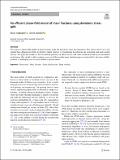| dc.contributor.author | Haghighat, Ehsan | |
| dc.contributor.author | Santillán, David | |
| dc.date.accessioned | 2023-05-30T13:39:21Z | |
| dc.date.available | 2023-05-30T13:39:21Z | |
| dc.date.issued | 2023-05-24 | |
| dc.identifier.uri | https://hdl.handle.net/1721.1/150822 | |
| dc.description.abstract | Abstract
We propose a phase-field model of shear fractures using the deviatoric stress decomposition. This choice allows us to use general three-dimensional Mohr–Coulomb’s failure function for formulating the relations and evaluating peak and residual stresses. We apply the model to a few benchmark problems of shear fracture and strain localization and report remarkable performance. Our model is able to capture conjugate failure modes under biaxial compression test and for the slope stability problem, a challenging task for most models of geomechanics. | en_US |
| dc.publisher | Springer Berlin Heidelberg | en_US |
| dc.relation.isversionof | https://doi.org/10.1007/s00466-023-02348-1 | en_US |
| dc.rights | Creative Commons Attribution | en_US |
| dc.rights.uri | http://creativecommons.org/licenses/by/4.0/ | en_US |
| dc.source | Springer Berlin Heidelberg | en_US |
| dc.title | An efficient phase-field model of shear fractures using deviatoric stress split | en_US |
| dc.type | Article | en_US |
| dc.identifier.citation | Haghighat, Ehsan and Santillán, David. 2023. "An efficient phase-field model of shear fractures using deviatoric stress split." | |
| dc.contributor.department | Massachusetts Institute of Technology. Department of Civil and Environmental Engineering | |
| dc.identifier.mitlicense | PUBLISHER_CC | |
| dc.eprint.version | Final published version | en_US |
| dc.type.uri | http://purl.org/eprint/type/JournalArticle | en_US |
| eprint.status | http://purl.org/eprint/status/PeerReviewed | en_US |
| dc.date.updated | 2023-05-28T03:14:05Z | |
| dc.language.rfc3066 | en | |
| dc.rights.holder | The Author(s) | |
| dspace.embargo.terms | N | |
| dspace.date.submission | 2023-05-28T03:14:05Z | |
| mit.license | PUBLISHER_CC | |
| mit.metadata.status | Authority Work and Publication Information Needed | en_US |
